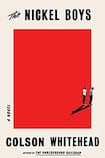
From the colonisation of the American land mass in the 15th century to the proliferation of white ethno-nationalism today, racist violence in the US has long contradicted any notion of an American Dream. African-Americans in particular have endured centuries of systemic cruelty, weighed down as much by white middle-American apathy as by the institutional horror of slavery.
In The Underground Railroad, which won the 2017 Pulitzer Prize and National Book Award, Colson Whitehead tapped into an America at odds with itself over police violence against black citizens. He showed us that these problems began with slavery and continued into the modern era with structural inequalities enshrined in the southern states’ Jim Crow laws, FBI harassment of black peace activists such as Martin Luther King, and the crack epidemic of the 1980s. In The Nickel Boys he continues the work of piecing together that jigsaw, through the exhumation of personal stories which white America would much rather forget.
The frank brutality of the book is all the more startling when we remember how many real-life victims of racial prejudice have been children
The Nickel Boys tells the story of Elwood Curtis: an intelligent, politically engaged young high schooler who gets wrongly convicted of stealing a car on the day he is due to take his first class at college. Afterwards he is sent to the Nickel Academy for Boys – a juvenile detention centre in Florida which Whitehead said was based on the real-life experiences of former detainees at the Dozier School for Boys.
Elwood’s time at Nickel is marked by racial prejudice, beatings, bullying and a chronic lack of intellectual stimulation. In the midst of all this and on the edge of despair, he befriends a street-smart nomad named Turner; an orphan and Artful Dodger-esque figure who strips Elwood of his naivety, steering him through some of the more difficult aspects of life at the centre. In this sense the book is a distant cousin of William Maxwell’s So Long, See You Tomorrow or Tobias Wolff’s Old School, though the personal narrative here is so thoroughly connected to the political that Whitehead seems to have created a new paradigm for the roman-a-clef.
The frank brutality of the book is all the more startling when we remember how many real-life victims of racial prejudice have been children. Emmett Till, Trayvon Martin and Michael Brown were all teenagers when they fell victim to racist violence, and there are countless others throughout American history who have not been named. Many African-American children have not been afforded the opportunity to live their lives as children and nowhere does Whitehead make this more apparent than early in the novel, when Elwood is handed a sign at a civil rights march with the declaration I AM A MAN printed on it.
Whitehead is clearly a natural storyteller. The Nickel Boys unspools itself as effortlessly as a Richard Yates novel and at each point feels as devastatingly real. The language is controlled, laconic and detailed. Whitehead triggers the senses with small verbal cues here and there so that we can almost smell the leather of the Plymouth Elwood is arrested in. We can almost hear the nasty, bourbon soaked drawl of the cop as he approaches the car.
Naturalism
Whitehead also has an uncanny ability to visualise the landscapes that accompany these moments of tension. His naturalism is reminiscent of Jesmyn Ward’s Sing, Unburied, Sing, often evoking both horror and beauty in one fell swoop. In one scene, when Turner shows Elwood what the sadistic custody officer Spencer means when he talks about bringing someone “out back”, Whitehead writes: “Past the laundry were the dilapidated horse stables. The ceiling had given way long ago and nature had crept inside, with skeletal bushes and limp grasses rising in the stalls . . . There were two oaks on one side of the stables, with iron rings stabbed into the bark.” He then goes on to describe how inmates at Nickel were tied to the rings and beaten until they died or passed out.
Throughout the book, Whitehead seems to constantly remind us that there is a harmful convenience to forgetting past atrocities like these, atrocities which are nevertheless crucial to our understanding of modern issues. This is why The Nickel Boys feels so timely, it is a book which can be applied and reapplied because its themes are so thoroughly universal.
With its evisceration of, among other things, the criminal justice system in America, there are echoes of Ava DuVernay and Angela Davis’s critiques of the prison-industrial complex and the intersection between capital and racial inequality. There are echoes too of issues much closer to home, with the recent uncovering of mass infant graves at Tuam in Co Galway and the ongoing exposure of clerical abuse in Ireland’s Magdalene laundries.
This means that when the final turn does come in the book, we are forced once again into confronting the politics of forgetting. Which is why issues such as racial inequality continue to exist. Which is why Whitehead’s writing will continue to endure.










